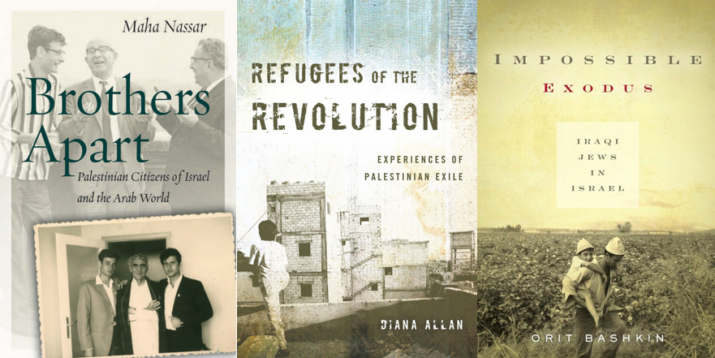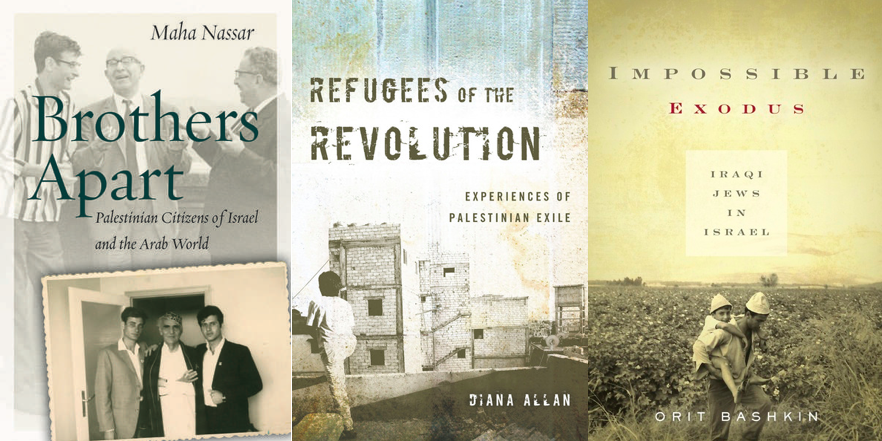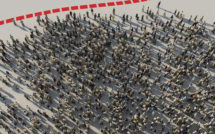

This is part of our special feature on forced migration, Narration on the Move.
This is part of our campus spotlight on Vassar College.
How does displacement affect collective identity? Each of the three books in this review examines the traumatic effects of displacement in shaping the identities of three distinct, yet connected, “minority” groups of refugees and migrants. In Brothers Apart, Maha Nassar examines the agency that Palestinian citizens of Israel exercise in countering narratives of their passive agreement with Zionism while advancing ties with the Arab world. In Refugees of the Revolution, Experiences of Palestinian Exile, Diana Allan examines the origins of an identity for Palestinians that remained in exile in Lebanon after the Nakba (translated as “catastrophe,” when more than 700,000 Palestinians were expelled from their homeland during the 1947-1949 Palestinian War). And finally, Orit Bashkin’s work, Impossible Exodus, Iraqi Jews in Israel, presents a detailed depiction of the period of transition for Iraqi Jews in Israeli transit camps, as their efforts to incorporate their identity as with the majority were beset by perceptions of their identity as that of a minority.
Each book addresses the concept of a group’s “identity” under the assumption that any group’s identity is self-defined. Identity, however, is also presented as vulnerable narratives and definitions from outsiders who are not members of those groups, and as such, group identities must be defended. Nassar, Allan, and Bashkin focus their works on the role that individuals play in the struggle against those external forces, and their agency in maintaining “their” identity. Nassar finds that Palestinians living in Israel primarily use literature and poetry of individual authors to reinforce their self-defined identity against those external forces, as well as to share their struggle and despair with the surrounding Arab world. The identity of Palestinians who lived in Shatila, a refugee camp in Lebanon, where Allan spends several years conducting interviews, is shaped by their memory of what was their “home” prior to their exodus, versus what it has become in the contemporary moment. And for Iraqi Jews, Bashkin discusses how their Jewish identity becomes superseded by their Iraqi identity as they navigate through their new, Jewish-majority home. Of these three works, however, Diana Allan’s immersion in the Shatila refugee camp is the most compelling; her work features the words of the refugees presenting their own oral histories, grounding the academic discussion rather than subverting their words through any preconceptions of Palestinian identity. All three authors have a compelling focus on presenting individual voices as agents with the power to define their identity in changing circumstances.
In Brothers Apart, Maha Nassar establishes Palestinians’ agency in their fight against Israeli censorship and erasure by exploring literature as a medium of resistance. Nassar does an excellent job of identifying the “threat” of Israeli narratives of Zionism to Palestinian notions of identity. The author explains that as Israel was embarking on its own program of state-building, it could not allow the Palestinian “suspect minority” to question the legitimacy of the Zionist state of Israel by promoting their minority status and demands for rights, as well as seeking international Arab solidarity and recognition.[1] Consequently, state policies and narratives began emphasizing the “passiveness” of Palestinians remaining in Israel. The state introduced al-Yawm, an Arabic newspaper that began portraying the Palestinian refugees as “merely lamenting their sorrowful state” and as having accepted the legitimacy of Israel’s claim to statehood.[2] Palestinians responded and launched the first of many newspapers, al-Ittihad, which “depicted them as actively engaged in a broader struggle against multiple strands of imperial hegemony.”[3] Their intended audience, however, was not only domestic, but also international. In the 1950s, as the notion of “Arab unity” was rising in Arab countries such as Egypt and Algeria, the Palestinians in Israel felt the opposite. While Egypt and Algeria were in the process of removing themselves from the shackles of colonial and mandate rule, Palestinians in Israel, facing increased suppression and denial of their identity by the state of Israel, felt isolated from other post-colonial Arab identities. These newspapers, and later poetry festivals, were the Palestinians’ attempt to counter Israeli narratives by solidifying and producing Palestinian culture (celebrating their Arab-ness).
Nassar’s work revolves around the production and experiences of Mahmoud Darwish and Samih al-Qasim, two of “theleading luminaries of the Palestinian cultural scene.”[4] By following their exploits over time, Nassar highlights the constant tension in Palestinian affirmations of Arab identity that refrain from isolating themselves from Israel. For example, Darwish and Qasim’s expedition to the Seventh International Festival of Youth and Students in Sofia, Bulgaria, was exemplary of the larger conflict of these narratives. Darwish and Qasim had to tread a careful line at this event, because while “they wished to be embraced by Arab delegates, and by extension the Arab world, they knew that they could not do so if they were seen as being too closely affiliated with Israel.”[5] Nassar’s focus on the different international and domestic forces pulling on and shaping claims to Palestinian identity is compelling due to her focus on these two poets. Their individual perspective effectively portrays the delicacy of the situation. Nassar’s approach emphasizes individual perspectives from a specific moment; but how do self-definitions of a Palestinian identity change under the duress of exile, when the basis of that identity only comes from memory?
Nassar studies Palestinians defining their identity amidst rapid, monumental changes in their homeland, whereas Diana Allan looks at what contributes to Palestinian identity that is formed beyond their native lands, Allan focuses on how memory, the passage of time, and daily life challenges the shaping of Palestinian identity within the isolation of a refugee camp, Shatila, in Lebanon. She first introduces a new set of terms to understand the discussion of Palestinian refugees: “Palestinian refugees in Lebanon and elsewhere are almost always discussed in ideological terms, as if they dwelled entirely within a political realm…Everyday matters such as work, health, and homemaking have received very little scholarly attention.”[6] But Allan is also working against her own grain: “By helping to codify [the Nakba] as the core of national identity, were my colleagues and I making it harder for subsequent generations of refugees to articulate a sense of identity and belonging in their own terms?”[7] Throughout her work, Allan is focused on not allowing her own academic ideologies and preconceptions of Palestinian identity cloud her research and interviews with Palestinians in the late 2000s. Instead, Allan seeks to understand what Palestinians identify as changing notions of their identity within both memory and their own daily lives in the refugee camp Shatila.
Allan refers to her work as an “ethnography,” as her work is based on her time spent living in Shatila for several years. Her book is organized around her conversations with its residents, their stories, her own experiences of their daily struggles, and the changing foundations for their identities across generations. As Allan begins to dive into the issue, her two interactions with village elder Abu Nayef are particularly illustrative. Her first interaction with Abu Nayef takes place early on in her stay, in an almost formal interview setting. He has “important” memories, muhim, and he begins to recount the story of his village and Palestinian existence before Israel. Allan notes that “this oral memoir seemed practiced, even stylized. There were signs of prescriptive plotting, for instance, in the invocation of key political tropes: close relations with local Jewish communities prior to 1948.”[8] It is clear that Abu Nayef’s narrative presentation of Palestinian identity derives authority from his memory of the traumatic expulsion of Palestinians in 1948. His memory, which Allan notes as possibly catering to international narratives for Palestinian “right of return,” resonates with many claims to Palestinian identity in Shatila. And yet, one year later, Allan overhears Abu refusing to protest the U.N. and the 2003 Geneva Accord, saying “everyone ‘knows’ that the right of return is impossible.”[9] By catching this offhand comment, Allan brings out the duality of Palestinian identity in Shatila. On one hand, the memory of the Nakba provides the Palestinian refugees their identity for an international stage, where they seek their return to their claimed home. On the other hand, Allan’s account of the Palestinian’s fraught struggle for survival in Shatila shows that the basic needs of food, work, and sanitation become the primary reference points in Shatila residents’ identity, superseding their memories and claims to a Palestinian home. As Allan succinctly puts it: “The struggle to get by was now all-consuming, leaving little time for political or cultural life and muting nationalist aspiration. Refugees in Shatila had been left little choice but to “eat their god.””[10]
Together, Allan’s and Bashkin’s books highlight a lacuna on the part of Nassar’s study. Diversity among refugee groups is crucial to drawing any understanding their identities, in particular among the groups discussed here, since their refugee status is already derived from their ethnicity and/or religious beliefs. In homogenous ethnic and religious communities, the importance of gender and age diversity in understanding refugee identities is magnified. Unfortunately, women’s voices are absent from Nassar’s book. This may seem obvious at first; the book does, after all, have the title Brothers Apart. The two individuals she focuses on are both men. Nassar also makes it clear that her work focuses on “the perspectives of intellectuals and cultural producers.”[11] She defines these intellectuals by their own terms of self-identification, muthaqqafun, a group encompassing “high school and college graduates, teachers, writers, journalists, attorneys, and party organizers.”[12] Given this grouping of individuals, and the time and place of this study, it is not surprising that there is a disparity in the sources available to Nassar. Nassar does acknowledge the gender disparity—but in her footnotes: “It appears that the lack of female speakers was due to an oversight and the relative paucity of women in intellectual circles… Abu Salma… made a point of inviting more women to speak.”[13] It is understandably difficult to bring forward female voices if the disparity was so noticeable at the time. However, Nassar does introduce at least one female poet, Najwa Qa’war Farah, but only to introduce her opinion on speaking at a poetry festival.[14] How is it possible that Nassar acknowledges Najwa Qa’war Farah as a credible source on poetry festivals, yet does not introduce her work at all throughout the book? If Farah’s work was relevant at the time, what makes it irrelevant now? Nassar’s approach limits the potential contribution of female poets by pointing out the disparity of representation at poetry festivals and then continuing that disparity in her own work.
Women’s voices enhance Bashkin’s work illuminating the distress of Iraqi Jewish children in transit camps. At the start of her second chapter, “Children of Iraq, Children of Israel,” Bashkin introduces the autobiographical work of the female author Ge’ula Sehayek al-Ani, The Rooster Thief, and the main character, Amalia, a young girl (additionally, an example of a generational divide within the refugee community). Amalia’s experiences provide the reader a first-hand perspective on experiences that Bashkin describes. For example, many Iraqi fathers found themselves unable to practice their professed trades once they had arrived and settled in Israel, with sometimes devastating effects on their children. Bashkin tells the story of Eliyahu Ramim, “a construction worker [who] had to leave his job because of an illness. He wanted to open a grocery store in a transit camp but his request was turned down. In protest he left his children in the labor bureau.”[15] The increased stress on both parents in search of livelihoods was passed on to their children, which Amalia’s story demonstrates. Prior to the family’s migration to Israel, Amalia’s mother enjoyed a middle-class lifestyle. However, the increasing demands of life in transit camps overwhelmed her. To compensate, she forces Amalia to help her complete household tasks and chores.[16] Amalia begins to resent and eventually hate her mother for this, as these constant tasks and burdens prevent her from studying. It is later revealed that Amalia loves her school and studies because she viewed them both as “refuge and an entry point into mainstream Israeli society.”[17] Al-Ani’s work introduces an unexpected dimension of understanding the conflict in families to the reader. The case of Amalia demonstrates the strained relations within families, and in particular, the responsibilities of women within the household. Amalia’s story only makes the tapestry of Bashkin’s depiction of daily lives and struggles in transit camps richer and more complete.
Finally, Bashkin emphasizes the duality of Iraqi Jewish identity in the quest of Iraqi Jews to define themselves as citizens of Israel. These “migrant-citizens,” as Bashkin calls them, came to Israel on the premise of their Zionist brotherhood, but instead found themselves victim of discrimination due to their Mizrahi identity (descendants of Jewish communities in the Middle East). In their struggle against discrimination, Iraqi Jews had to overcome the “Iraqiness” that the Ashkenazi (descendants of Jewish diaspora communities that formed in the Holy Roman Empire) ruling class saw as their “unconscionable inability to help themselves.”[18] As the Iraqi Jews faced these injustices because of their Iraqi identity, they began to yearn for their previous home. While the refugees may have once “longed to come to Israel when they were in exile and accept the Zionist axiom that all Jews are brothers,” many short stories began emerging with the message that “Israel symbolizes a space of decline for people who are about to die.”[19] While Bashkin’s work primarily focuses on describing the camp conditions that Iraqi Jews faced, her use of stories like Amalia’s gives the refugees in the camps the opportunity to describe their struggles personally. Allowing the individual experiences and voices to come through recognizes these Iraqi Jews’ own agency as they struggle for their rights.
While Nassar, Allan, and Bashkin each focus on separate groups of minorities, their underlying premise remains the same. Each group, of Palestinians or Iraqis, in Israel or Lebanon, suddenly becomes a minority due to massive population movements and sudden displacement. This unsettlement, and newfound minority status, forced each one of these populations to reexamine their own identities, as their previous identities were being challenged by their new predicaments. Whether it is Zionist narratives, issues of maintaining livelihoods in refugee camps in Lebanon, or Ashkenazi majority discrimination against a Mizrahi minority, each book explores how individual voices resist these forces, or capture their destructive effects by describing those changes in minority identities. Each author utilizes the direct voices of individuals effectively to demonstrate their arguments, and to facilitate the larger function of their overall product.
The use of individual voices also serves as a potent reminder that beneath the broad discussions in the United States and Europe regarding “minority” and “refugee” identities, the individuals themselves are generally forgotten, or lost. While the “right to return” is negotiated behind closed doors in Switzerland, children in Shatila might go to bed hungry, or familial bonds between Iraqi Jews in transit camps might become unraveled by changing social dynamics. Nassar, Allan, and Bashkin do not allow us to forget that behind the larger narratives about refugees, stand the refugees themselves.
Some questions, however, remain. Nassar’s book, in particular, invites further investigation of the contributions of female writers and poets to the arguments surrounding Palestinian identity. Overall, the works are compelling studies that contribute positively to the growing field of Middle Eastern studies. They contribute to the ongoing pushback against the influence of Orientalist thought and scholarship regarding the Middle East, specifically Palestine. For instance, one of the strongest Orientalist characterizations of the Arab world by Europe and the West is that it, and its people(s), is static, and unchanging. Yet, the subjects of the books portray themselves and their identities as the complete opposite. Furthermore, the books’ subjects and authors make clear that the cause of this dynamism is very much rooted in the colonialist and imperialist legacies of Europe in the Middle East, and the resulting displacement of people across the region. As such, each one of these books would serve as an excellent resource for students to examine the shaping of minority identities in Israel and Palestine throughout the twentieth century.
Desmond Curran is a recent graduate of Vassar College, and has begun working in Washington, D.C. At Vassar, Desmond was a History and Hispanic Studies double major, a scholar-athlete on the men’s soccer team, and a representative in student government. His senior thesis investigated the United States’ acquisition of the Philippines following the Spanish American War of 1898. He also translated two chapters from Gonzalo Fernández de Oviedo’s Historia general y natural de las Indias that will be published by the Oviedo Project at Vassar College. He would like to thank Matthew Brill-Carlat for noticing his essay in the Vassar History Review.
Brothers Apart, Palestinian Citizens of Israel and the Arab World
by Maha Nassar
Publisher: Stanford University Press
Paperback / pages 308 / 2017
ISBN: 9781503602496
Refugees of the Revolution, Experiences of Palestinian Exile
by Diana Allan
Publisher: Stanford University Press
Paperback / pages 328 / 2013
ISBN: 9780804774918
Impossible Exodus, Iraqi Jews in Israel
by Orit Bashkin
Publisher: Stanford University Press
Hardcover / pages 278 / 2017
ISBN: 9780804795852
References
[1] Maha Nassar, Brothers Apart, Palestinian Citizens of Israel and the Arab World, (Stanford, California: Stanford University Press, 2017), 46,47.
[2] Maha Nassar, Brothers Apart, 56.
[3] Ibid.
[4] Ibid., 88.
[5] Ibid., 166.
[6] Diana Allan, Refugees of the Revolution, Experiences of Palestinian Exile, (Stanford, California: Stanford University Press, 2014), 5-6.
[7] Allan, Refugees of the Revolution, 7.
[8] Ibid., 46.
[9] Ibid., 48.
[10] Ibid., 2.
[11] Nassar, Brothers Apart, 8.
[12] Ibid., 10.
[13] Ibid., 201.
[14] Ibid., 86.
[15] Orit Bashkin, Impossible Exodus, Iraqi Jews in Israel, (Stanford, California: Stanford University Press, 2017), 71-72.
[16] Bashkin, Impossible Exodus, 73.
[17] Ibid., 82.
[18] Ibid., 92-93.
[19] Ibid., 162, 188.
Published on October 29, 2019.




